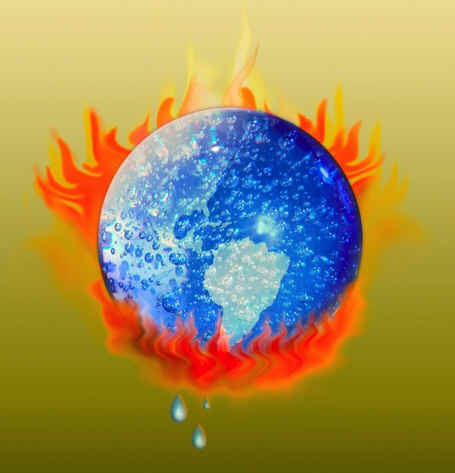
Global warming is the increase in the average temperature of the Earth's near-surface air and oceans since the mid-20th century and its projected continuation. Global surface temperature increased 0.74 ± 0.18 °C (1.33 ± 0.32 °F) between the start and the end of the 20th century.[1][A] The Intergovernmental Panel on Climate Change (IPCC) concludes that most of the observed temperature increase since the middle of the 20th century was caused by increasing concentrations of greenhouse gases resulting from human activity such as fossil fuel burning and deforestation.[1] The IPCC also concludes that variations in natural phenomena such as solar radiation and volcanoes produced most of the warming from pre-industrial times to 1950 and had a small cooling effect afterward.[2][3] These basic conclusions have been endorsed by more than 40 scientific societies and academies of science,[B] including all of the national academies of science of the major industrialized countries.[4]
Climate model projections summarized in the latest IPCC report indicate that the global surface temperature will probably rise a further 1.1 to 6.4 °C (2.0 to 11.5 °F) during the twenty-first century.[1] The uncertainty in this estimate arises from the use of models with differing sensitivity to greenhouse gas concentrations and the use of differing estimates of future greenhouse gas emissions. Some other uncertainties include how warming and related changes will vary from region to region around the globe. Most studies focus on the period up to the year 2100. However, warming is expected to continue beyond 2100 even if emissions stop, because of the large heat capacity of the oceans and the long lifetime of carbon dioxide in the atmosphere.[5][6]
An increase in global temperature will cause sea levels to rise and will change the amount and pattern of precipitation, probably including expansion of subtropical deserts.[7] The continuing retreat of glaciers, permafrost and sea ice is expected, with warming being strongest in the Arctic. Other likely effects include increases in the intensity of extreme weather events, species extinctions, and changes in agricultural yields.
Political and public debate continues regarding climate change, and what actions (if any) to take in response. The available options are mitigation to reduce further emissions; adaptation to reduce the damage caused by warming; and, more speculatively, geoengineering to reverse global warming. Most national governments have signed and ratified the Kyoto Protocol aimed at reducing greenhouse gas emissions.
Temperature changes
Main article: Temperature record
Two millennia of mean surface temperatures according to different reconstructions, each smoothed on a decadal scale. The unsmoothed, annual value for 2004 is also plotted for reference.
The most commonly discussed measure of global warming is the trend in globally averaged temperature near the Earth's surface. Expressed as a linear trend, this temperature rose by 0.74°C ±0.18°C over the period 1906–2005. The rate of warming over the last half of that period was almost double that for the period as a whole (0.13°C ±0.03°C per decade, versus 0.07°C ± 0.02°C per decade). The urban heat island effect is estimated to account for about 0.002 °C of warming per decade since 1900.[8] Temperatures in the lower troposphere have increased between 0.12 and 0.22 °C (0.22 and 0.4 °F) per decade since 1979, according to satellite temperature measurements. Temperature is believed to have been relatively stable over the one or two thousand years before 1850, with regionally-varying fluctuations such as the Medieval Warm Period or the Little Ice Age.
Based on estimates by NASA's Goddard Institute for Space Studies, 2005 was the warmest year since reliable, widespread instrumental measurements became available in the late 1800s, exceeding the previous record set in 1998 by a few hundredths of a degree.[9] Estimates prepared by the World Meteorological Organization and the Climatic Research Unit concluded that 2005 was the second warmest year, behind 1998.[10][11] Temperatures in 1998 were unusually warm because the strongest El Niño in the past century occurred during that year.[12] Global temperature is subject to short-term fluctuations that overlay long term trends and can temporarily mask them. The relative stability in temperature from 1999 to 2009 is consistent with such an episode.[13][14]
Temperature changes vary over the globe. Since 1979, land temperatures have increased about twice as fast as ocean temperatures (0.25 °C per decade against 0.13 °C per decade).[15] Ocean temperatures increase more slowly than land temperatures because of the larger effective heat capacity of the oceans and because the ocean loses more heat by evaporation.[16] The Northern Hemisphere warms faster than the Southern Hemisphere because it has more land and because it has extensive areas of seasonal snow and sea-ice cover subject to ice-albedo feedback. Although more greenhouse gases are emitted in the Northern than Southern Hemisphere this does not contribute to the difference in warming because the major greenhouse gases persist long enough to mix between hemispheres.[17]
The thermal inertia of the oceans and slow responses of other indirect effects mean that climate can take centuries or longer to adjust to changes in forcing. Climate commitment studies indicate that even if greenhouse gases were stabilized at 2000 levels, a further warming of about 0.5 °C (0.9 °F) would still occur.[18]
Radiative forcing
Main article: Radiative forcing
External forcing is a term used in climate science for processes external to the climate system (though not necessarily external to Earth). Climate responds to several types of external forcing, such as changes in greenhouse gas concentrations, changes in solar luminosity, volcanic eruptions, and variations in Earth's orbit around the Sun.[2] Attribution of recent climate change focuses on the first three types of forcing. Orbital cycles vary slowly over tens of thousands of years and thus are too gradual to have caused the temperature changes observed in the past century.
Greenhouse gases
Main articles: Greenhouse gas and Greenhouse effect
Greenhouse effect schematic showing energy flows between space, the atmosphere, and earth's surface. Energy exchanges are expressed in watts per square meter (W/m2).
Recent atmospheric carbon dioxide (CO2) increases. Monthly CO2 measurements display seasonal oscillations in overall yearly uptrend; each year's maximum occurs during the Northern Hemisphere's late spring, and declines during its growing season as plants remove some atmospheric CO2.
The greenhouse effect is the process by which absorption and emission of infrared radiation by gases in the atmosphere warm a planet's lower atmosphere and surface. It was discovered by Joseph Fourier in 1824 and was first investigated quantitatively by Svante Arrhenius in 1896.[19] Existence of the greenhouse effect as such is not disputed, even by those who do not agree that the recent temperature increase is attributable to human activity. The question is instead how the strength of the greenhouse effect changes when human activity increases the concentrations of greenhouse gases in the atmosphere.
Naturally occurring greenhouse gases have a mean warming effect of about 33 °C (59 °F).[20][C] The major greenhouse gases are water vapor, which causes about 36–70 percent of the greenhouse effect; carbon dioxide (CO2), which causes 9–26 percent; methane (CH4), which causes 4–9 percent[not in citation given]; and ozone (O3), which causes 3–7 percent.[21][22] Clouds also affect the radiation balance, but they are composed of liquid water or ice and so are considered separately from water vapor and other gases.
Human activity since the Industrial Revolution has increased the amount of greenhouse gases in the atmosphere, leading to increased radiative forcing from CO2, methane, tropospheric ozone, CFCs and nitrous oxide. The concentrations of CO2 and methane have increased by 36% and 148% respectively since the mid-1700s.[23] These levels are much higher than at any time during the last 650,000 years, the period for which reliable data has been extracted from ice cores.[24] Less direct geological evidence indicates that CO2 values this high were last seen about 20 million years ago.[25] Fossil fuel burning has produced about three-quarters of the increase in CO2 from human activity over the past 20 years. Most of the rest is due to land-use change, particularly deforestation.[26]
CO2 concentrations are continuing to rise due to burning of fossil fuels and land-use change. The future rate of rise will depend on uncertain economic, sociological, technological, and natural developments. Accordingly, the IPCC Special Report on Emissions Scenarios gives a wide range of future CO2 scenarios, ranging from 541 to 970 ppm by the year 2100.[27] Fossil fuel reserves are sufficient to reach these levels and continue emissions past 2100 if coal, tar sands or methane clathrates are extensively exploited.[28]
The destruction of stratospheric ozone by chlorofluorocarbons is sometimes mentioned in relation to global warming. Although there are a few areas of linkage, the relationship between the two is not strong. Reduction of stratospheric ozone has a cooling influence, but substantial ozone depletion did not occur until the late 1970s.[29] Tropospheric ozone contributes to surface warming.[30]
Aerosols and soot
Ship tracks over the Atlantic Ocean on the east coast of the United States. The climatic impacts from aerosol forcing could have a large effect on climate through the indirect effect.
Global dimming, a gradual reduction in the amount of global direct irradiance at the Earth's surface, has partially counteracted global warming from 1960 to the present.[31] The main cause of this dimming is aerosols produced by volcanoes and pollutants. These aerosols exert a cooling effect by increasing the reflection of incoming sunlight. James Hansen and colleagues have proposed that the effects of the products of fossil fuel combustion—CO2 and aerosols—have largely offset one another in recent decades, so that net warming has been driven mainly by non-CO2 greenhouse gases.[32]
In addition to their direct effect by scattering and absorbing solar radiation, aerosols have indirect effects on the radiation budget.[33] Sulfate aerosols act as cloud condensation nuclei and thus lead to clouds that have more and smaller cloud droplets. These clouds reflect solar radiation more efficiently than clouds with fewer and larger droplets.[34] This effect also causes droplets to be of more uniform size, which reduces growth of raindrops and makes the cloud more reflective to incoming sunlight.[35]
Soot may cool or warm, depending on whether it is airborne or deposited. Atmospheric soot aerosols directly absorb solar radiation, which heats the atmosphere and cools the surface. Regionally (but not globally), as much as 50% of surface warming due to greenhouse gases may be masked by atmospheric brown clouds.[36] When deposited, especially on glaciers or on ice in arctic regions, the lower surface albedo can also directly heat the surface.[37] The influences of aerosols, including black carbon, are most pronounced in the tropics and sub-tropics, particularly in Asia, while the effects of greenhouse gases are dominant in the extratropics and southern hemisphere.[38]
Solar variation
Main article: Solar variation
Solar variation over the last thirty years.
Variations in solar output have been the cause of past climate changes,[39] but solar forcing is generally thought to be too small to account for a significant part of global warming in recent decades.[40][41] However, a recent phenomenological analysis indicates that the contribution of solar forcing may be underestimated.[42]
Greenhouse gases and solar forcing affect temperatures in different ways. While both increased solar activity and increased greenhouse gases are expected to warm the troposphere, an increase in solar activity should warm the stratosphere while an increase in greenhouse gases should cool the stratosphere.[2] Observations show that temperatures in the stratosphere have been steady or cooling since 1979, when satellite measurements became available. Radiosonde (weather balloon) data from the pre-satellite era show cooling since 1958, though there is greater uncertainty in the early radiosonde record.[43]
A related hypothesis, proposed by Henrik Svensmark, is that magnetic activity of the sun deflects cosmic rays that may influence the generation of cloud condensation nuclei and thereby affect the climate.[44] Other research has found no relation between warming in recent decades and cosmic rays.[45][46] A recent study concluded that the influence of cosmic rays on cloud cover is about a factor of 100 lower than needed to explain the observed changes in clouds or to be a significant contributor to present-day climate change.[47]
Feedback
Main article: Effects of global warming
A positive feedback is a process that amplifies some change. Thus, when a warming trend results in effects that induce further warming, the result is a positive feedback; when the warming results in effects that reduce the original warming, the result is a negative feedback. The main positive feedback in global warming involves the tendency of warming to increase the amount of water vapor in the atmosphere. The main negative feedback in global warming is the effect of temperature on emission of infrared radiation: as the temperature of a body increases, the emitted radiation increases with the fourth power of its absolute temperature.
Water vapor feedback
If the atmosphere is warmed, the saturation vapor pressure increases, and the amount of water vapor in the atmosphere will tend to increase. Since water vapor is a greenhouse gas, the increase in water vapor content makes the atmosphere warm further; this warming causes the atmosphere to hold still more water vapor (a positive feedback), and so on until other processes stop the feedback loop. The result is a much larger greenhouse effect than that due to CO2 alone. Although this feedback process causes an increase in the absolute moisture content of the air, the relative humidity stays nearly constant or even decreases slightly because the air is warmer.[48]
Cloud feedback
Warming is expected to change the distribution and type of clouds. Seen from below, clouds emit infrared radiation back to the surface, and so exert a warming effect; seen from above, clouds reflect sunlight and emit infrared radiation to space, and so exert a cooling effect. Whether the net effect is warming or cooling depends on details such as the type and altitude of the cloud. These details were poorly observed before the advent of satellite data and are difficult to represent in climate models.[48]
Lapse rate
The atmosphere's temperature decreases with height in the troposphere. Since emission of infrared radiation varies with temperature, longwave radiation escaping to space from the relatively cold upper atmosphere is less than that emitted toward the ground from the lower atmosphere. Thus, the strength of the greenhouse effect depends on the atmosphere's rate of temperature decrease with height. Both theory and climate models indicate that global warming will reduce the rate of temperature decrease with height, producing a negative lapse rate feedback that weakens the greenhouse effect. Measurements of the rate of temperature change with height are very sensitive to small errors in observations, making it difficult to establish whether the models agree with observations.[49]
Ice-albedo feedback
Aerial photograph showing a section of sea ice. The lighter blue areas are melt ponds and the darkest areas are open water, both have a lower albedo than the white sea ice. The melting ice contributes to ice-albedo feedback.
When ice melts, land or open water takes its place. Both land and open water are on average less reflective than ice and thus absorb more solar radiation. This causes more warming, which in turn causes more melting, and this cycle continues.[50]
Arctic methane release
Warming is also the triggering variable for the release of methane in the arctic.[51] Methane released from thawing permafrost such as the frozen peat bogs in Siberia, and from methane clathrate on the sea floor, creates a positive feedback.[52]
Reduced absorption of CO2 by the oceanic ecosystems
Ocean ecosystems' ability to sequester carbon is expected to decline as the oceans warm. This is because warming reduces the nutrient levels of the mesopelagic zone (about 200 to 1000 m deep), which limits the growth of diatoms in favor of smaller phytoplankton that are poorer biological pumps of carbon.[53]
CO2 release from oceans
Cooler water can absorb more CO2. As ocean temperatures rise some of this CO2 will be released. This is one of the main reasons why atmospheric CO2 is lower during an ice age. There is a greater mass of CO2 contained in the oceans than there is in the atmosphere.
Gas release
Release of gases of biological origin may be affected by global warming, but research into such effects is at an early stage. Some of these gases, such as nitrous oxide released from peat, directly affect climate.[54] Others, such as dimethyl sulfide released from oceans, have indirect effects.[55]
Climate models
Main article: Global climate model
Calculations of global warming prepared in or before 2001 from a range of climate models under the SRES A2 emissions scenario, which assumes no action is taken to reduce emissions and regionally divided economic development.
The geographic distribution of surface warming during the 21st century calculated by the HadCM3 climate model if a business as usual scenario is assumed for economic growth and greenhouse gas emissions. In this figure, the globally averaged warming corresponds to 3.0 °C (5.4 °F).
The main tools for projecting future climate changes are mathematical models based on physical principles including fluid dynamics, thermodynamics and radiative transfer. Although they attempt to include as many processes as possible, simplifications of the actual climate system are inevitable because of the constraints of available computer power and limitations in knowledge of the climate system. All modern climate models are in fact combinations of models for different parts of the Earth. These include an atmospheric model for air movement, temperature, clouds, and other atmospheric properties; an ocean model that predicts temperature, salt content, and circulation of ocean waters; models for ice cover on land and sea; and a model of heat and moisture transfer from soil and vegetation to the atmosphere. Some models also include treatments of chemical and biological processes.[56] Warming due to increasing levels of greenhouse gases is not an assumption of the models; rather, it is an end result from the interaction of greenhouse gases with radiative transfer and other physical processes in the models.[57] Although much of the variation in model outcomes depends on the greenhouse gas emissions used as inputs, the temperature effect of a specific greenhouse gas concentration (climate sensitivity) varies depending on the model used. The representation of clouds is one of the main sources of uncertainty in present-generation models.[58]
Global climate model projections of future climate most often have used estimates of greenhouse gas emissions from the IPCC Special Report on Emissions Scenarios (SRES). In addition to human-caused emissions, some models also include a simulation of the carbon cycle; this generally shows a positive feedback, though this response is uncertain. Some observational studies also show a positive feedback.[59][60][61] Including uncertainties in future greenhouse gas concentrations and climate sensitivity, the IPCC anticipates a warming of 1.1 °C to 6.4 °C (2.0 °F to 11.5 °F) by the end of the 21st century, relative to 1980–1999.[1]
Models are also used to help investigate the causes of recent climate change by comparing the observed changes to those that the models project from various natural and human-derived causes. Although these models do not unambiguously attribute the warming that occurred from approximately 1910 to 1945 to either natural variation or human effects, they do indicate that the warming since 1970 is dominated by man-made greenhouse gas emissions.[62]
The physical realism of models is tested by examining their ability to simulate current or past climates.[63] Current climate models produce a good match to observations of global temperature changes over the last century, but do not simulate all aspects of climate.[26] Not all effects of global warming are accurately predicted by the climate models used by the IPCC. For example, observed Arctic shrinkage has been faster than that predicted.[64]
Attributed and expected effects
Environmental
Main articles: Effects of global warming and Regional effects of global warming
Sparse records indicate that glaciers have been retreating since the early 1800s. In the 1950s measurements began that allow the monitoring of glacial mass balance, reported to the WGMS and the NSIDC.
It is usually impossible to connect specific weather events to global warming. Instead, global warming is expected to cause changes in the overall distribution and intensity of events, such as changes to the frequency and intensity of heavy precipitation. Broader effects are expected to include glacial retreat, Arctic shrinkage, and worldwide sea level rise. Some effects on both the natural environment and human life are, at least in part, already being attributed to global warming. A 2001 report by the IPCC suggests that glacier retreat, ice shelf disruption such as that of the Larsen Ice Shelf, sea level rise, changes in rainfall patterns, and increased intensity and frequency of extreme weather events are attributable in part to global warming.[65] Other expected effects include water scarcity in some regions and increased precipitation in others, changes in mountain snowpack, and some adverse health effects from warmer temperatures.[66]
Social and economic effects of global warming may be exacerbated by growing population densities in affected areas. Temperate regions are projected to experience some benefits, such as fewer cold-related deaths.[67] A summary of probable effects and recent understanding can be found in the report made for the IPCC Third Assessment Report by Working Group II.[65] The newer IPCC Fourth Assessment Report summary reports that there is observational evidence for an increase in intense tropical cyclone activity in the North Atlantic Ocean since about 1970, in correlation with the increase in sea surface temperature (see Atlantic Multidecadal Oscillation), but that the detection of long-term trends is complicated by the quality of records prior to routine satellite observations. The summary also states that there is no clear trend in the annual worldwide number of tropical cyclones.[1]
Additional anticipated effects include sea level rise of 0.18 to 0.59 meters (0.59 to 1.9 ft) in 2090–2100 relative to 1980–1999,[1] new trade routes resulting from arctic shrinkage,[68] possible thermohaline circulation slowing, increasingly intense (but less frequent) hurricanes and extreme weather events,[69] reductions in the ozone layer, changes in agriculture yields, changes in the range of climate-dependent disease vectors,[70] which have been linked to increases in the prevalence of malaria and dengue fever,[71] and ocean oxygen depletion.[72] Increased atmospheric CO2 increases the amount of CO2 dissolved in the oceans.[73] CO2 dissolved in the ocean reacts with water to form carbonic acid, resulting in ocean acidification. Ocean surface pH is estimated to have decreased from 8.25 near the beginning of the industrial era to 8.14 by 2004,[74] and is projected to decrease by a further 0.14 to 0.5 units by 2100 as the ocean absorbs more CO2.[1][75] Heat and carbon dioxide trapped in the oceans may still take hundreds of years to be re-emitted, even after greenhouse gas emissions are eventually reduced.[6] Since organisms and ecosystems are adapted to a narrow range of pH, this raises extinction concerns and disruptions in food webs.[76] One study predicts 18% to 35% of a sample of 1,103 animal and plant species would be extinct by 2050, based on future climate projections.[77] However, few mechanistic studies have documented extinctions due to recent climate change,[78] and one study suggests that projected rates of extinction are uncertain.[79]
Economic
Main articles: Economics of global warming and Low-carbon economy
Projected temperature increase for a range of stabilization scenarios (the colored bands). The black line in middle of the shaded area indicates 'best estimates'; the red and the blue lines the likely limits. From IPCC AR4.
The IPCC reports the aggregate net economic costs of damages from climate change globally (discounted to the specified year). In 2005, the average social cost of carbon from 100 peer-reviewed estimates is US$12 per tonne of CO2, but range -$3 to $95/tCO2. The IPCC's gives these cost estimates with the caveats, "Aggregate estimates of costs mask significant differences in impacts across sectors, regions and populations and very likely underestimate damage costs because they cannot include many non-quantifiable impacts."[80]
One widely publicized report on potential economic impact is the Stern Review, written by Sir Nicholas Stern. It suggests that extreme weather might reduce global gross domestic product by up to one percent, and that in a worst-case scenario global per capita consumption could fall by the equivalent of 20 percent.[81] The response to the Stern Review was mixed. The Review's methodology, advocacy and conclusions were criticized by several economists, including Richard Tol, Gary Yohe,[82] Robert Mendelsohn[83] and William Nordhaus.[84] Economists that have generally supported the Review include Terry Barker,[85] William Cline,[86] and Frank Ackerman.[87] According to Barker, the costs of mitigating climate change are 'insignificant' relative to the risks of unmitigated climate change.[88]
According to United Nations Environment Programme (UNEP), economic sectors likely to face difficulties related to climate change include banks, agriculture, transport and others.[89] Developing countries dependent upon agriculture will be particularly harmed by global warming.[90]
Responses to global warming
The broad agreement among climate scientists that global temperatures will continue to increase has led some nations, states, corporations and individuals to implement responses. These responses to global warming can be divided into mitigation of the causes and effects of global warming, adaptation to the changing global environment, and geoengineering to reverse global warming.
Mitigation
Main article: Mitigation of global warming
Carbon capture and storage (CCS) is an approach to mitigation. Emissions may be sequestered from fossil fuel power plants, or removed during processing in hydrogen production. When used on plants, it is known as bio-energy with carbon capture and storage.
Mitigation of global warming is accomplished through reductions in the rate of anthropogenic greenhouse gas release. Models suggest that mitigation can quickly begin to slow global warming, but that temperatures will appreciably decrease only after several centuries.[91] The world's primary international agreement on reducing greenhouse gas emissions is the Kyoto Protocol, an amendment to the UNFCCC negotiated in 1997. The Protocol now covers more than 160 countries and over 55 percent of global greenhouse gas emissions.[92] As of June 2009, only the United States, historically the world's largest emitter of greenhouse gases, has refused to ratify the treaty. The treaty expires in 2012. International talks began in May 2007 on a future treaty to succeed the current one.[93] UN negotiations are now gathering pace in advance of a meeting in Copenhagen in December 2009.[94]
Many environmental groups encourage individual action against global warming, as well as community and regional actions. Others have suggested a quota on worldwide fossil fuel production, citing a direct link between fossil fuel production and CO2 emissions.[95][96]
There has also been business action on climate change, including efforts to improve energy efficiency and limited moves towards use of alternative fuels. In January 2005 the European Union introduced its European Union Emission Trading Scheme, through which companies in conjunction with government agree to cap their emissions or to purchase credits from those below their allowances. Australia announced its Carbon Pollution Reduction Scheme in 2008. United States President Barack Obama has announced plans to introduce an economy-wide cap and trade scheme.[97]
The IPCC's Working Group III is responsible for crafting reports on mitigation of global warming and the costs and benefits of different approaches. The 2007 IPCC Fourth Assessment Report concludes that no one technology or sector can be completely responsible for mitigating future warming. They find there are key practices and technologies in various sectors, such as energy supply, transportation, industry, and agriculture, that should be implemented to reduced global emissions. They estimate that stabilization of carbon dioxide equivalent between 445 and 710 ppm by 2030 will result in between a 0.6 percent increase and three percent decrease in global gross domestic product.[98]
Adaptation
Main article: Adaptation to global warming
A wide variety of measures have been suggested for adaptation to global warming. These measures range from the trivial, such as the installation of air-conditioning equipment, to major infrastructure projects, such as abandoning settlements threatened by sea level rise.
Measures including water conservation,[99] water rationing, adaptive agricultural practices,[100] construction of flood defences,[101] Martian colonization,[102] changes to medical care,[103] and interventions to protect threatened species[104] have all been suggested. A wide-ranging study of the possible opportunities for adaptation of infrastructure has been published by the Institute of Mechanical Engineers.[105]
Geoengineering
Main article: Geoengineering
Geoengineering is the deliberate modification of Earth's natural environment on a large scale to suit human needs.[106] An example is greenhouse gas remediation, which removes greenhouse gases from the atmosphere, usually through carbon sequestration techniques such as carbon dioxide air capture.[107] Solar radiation management reduces absorbed solar radiation, such as by the addition of stratospheric sulfur aerosols[108] or cool roof techniques.[109] No large-scale geoengineering projects have yet been undertaken.
Debate and skepticism
Main articles: Global warming controversy and Politics of global warming
See also: Scientific opinion on climate change and Climate change denial
Per capita greenhouse gas emissions in 2000, including land-use change.
Per country greenhouse gas emissions in 2000, including land-use change.
Increased publicity of the scientific findings surrounding global warming has resulted in political and economic debate.[110] Poor regions, particularly Africa, appear at greatest risk from the projected effects of global warming, while their emissions have been small compared to the developed world.[111] The exemption of developing countries from Kyoto Protocol restrictions has been used to justify non-ratification by the U.S. and a previous Australian Government.[112] (Australia has since ratified the Kyoto protocol.)[113] Another point of contention is the degree to which emerging economies such as India and China should be expected to constrain their emissions.[114] The U.S. contends that if it must bear the cost of reducing emissions, then China should do the same[115][116] since China's gross national CO2 emissions now exceed those of the U.S.[117][118][119] China has contended that it is less obligated to reduce emissions since its per capita responsibility and per capita emissions are less that of the U.S.[120] India, also exempt, has made similar contentions.[121]
In 2007–2008 Gallup Polls surveyed 127 countries. Over a third of the world's population were unaware of global warming, with developing countries less aware than developed, and Africa the least aware. Of those aware, Latin America leads in belief that temperature changes are a result of human activities while Africa, parts of Asia and the Middle East, and a few countries from the Former Soviet Union lead in the opposite belief.[122] In the western world, the concept and the appropriate responses are contested. Nick Pidgeon of Cardiff University finds that "results show the different stages of engagement about global warming on each side of the Atlantic"; where Europe debates the appropriate responses while the United States debates whether climate change is happening.[123]
Debates weigh the benefits of limiting industrial emissions of greenhouse gases against the costs that such changes would entail.[98] Using economic incentives, alternative and renewable energy have been promoted to reduce emissions while building infrastructure.[124][125] Business-centered organizations such as the Competitive Enterprise Institute, conservative commentators, and companies such as ExxonMobil have downplayed IPCC climate change scenarios, funded scientists who disagree with the scientific consensus, and provided their own projections of the economic cost of stricter controls.[126][127][128][129] Environmental organizations and public figures have emphasized changes in the current climate and the risks they entail, while promoting adaptation to changes in infrastructural needs and emissions reductions.[130] Some fossil fuel companies have scaled back their efforts in recent years,[131] or called for policies to reduce global warming.[132]
Some global warming skeptics in the science or political communities dispute all or some of the global warming scientific consensus, questioning whether global warming is actually occurring, whether human activity has contributed significantly to the warming, and the magnitude of the threat posed by global warming. Prominent global warming skeptics include Richard Lindzen, Fred Singer, Patrick Michaels, John Christy, Stephen McIntyre and Robert Balling.
























